Introduction – Why Augers Are Essential in Construction
What is an auger? An auger is a tool or drill bit used for boring holes. In the context of construction and drilling, an auger is a drilling tool with a rotating helical screw blade used to dig holes in the ground. Augers are commonly used to drill holes for footings, fencing, signs, trees, and shrubs. For larger diameter holes, such as those used for direct-burial poles and footings, a power auger may be used.
An auger is a drilling device used to bore holes into the earth, wood, ice, and even concrete, delivering precise results for numerous construction and drilling tasks. Knowing the different types, how it works, and specific uses will help you determine if it’s the right tool for your drilling project.
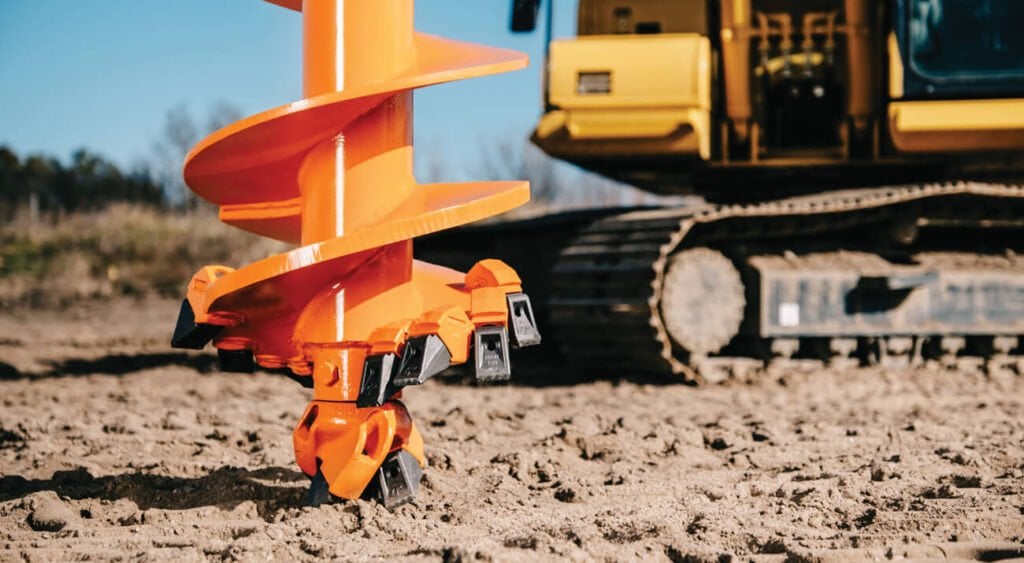
1. What Is an Auger?
An auger is a specialized drilling tool that uses a helical screw blade to bore precise holes in various materials such as soil, wood, ice, and even concrete. Augers are designed to remove material from the hole as they drill, ensuring efficient operation with minimal effort.
1.1. Key Components of an Auger
Augers consist of several essential parts that contribute to their functionality and efficiency:
- Flighting (Helix Blade): It’s the spiral blade of the auger that picks up the material and pulls it out of the hole you are digging. The size and angle of the flighting play a significant role in how effectively the auger displaces the material in the hole.
- Shank/Drive Shaft: This is the long rod that connects the auger to the power source to ensure that rotational force is transferred efficiently.
- Cutting Edge/Tip: The sharp, pointed piece at the bottom of the auger bit that goes into the ground first and starts the process digging.
- Auger Head: In the case of a larger, machine-mounted auger, an auger head may include special teeth or other specialized attachments for the ground conditions or the hole being dug.
Augers come in a wide range of sizes, from small, handheld models for light-duty work to massive hydraulic augers used for heavy construction.
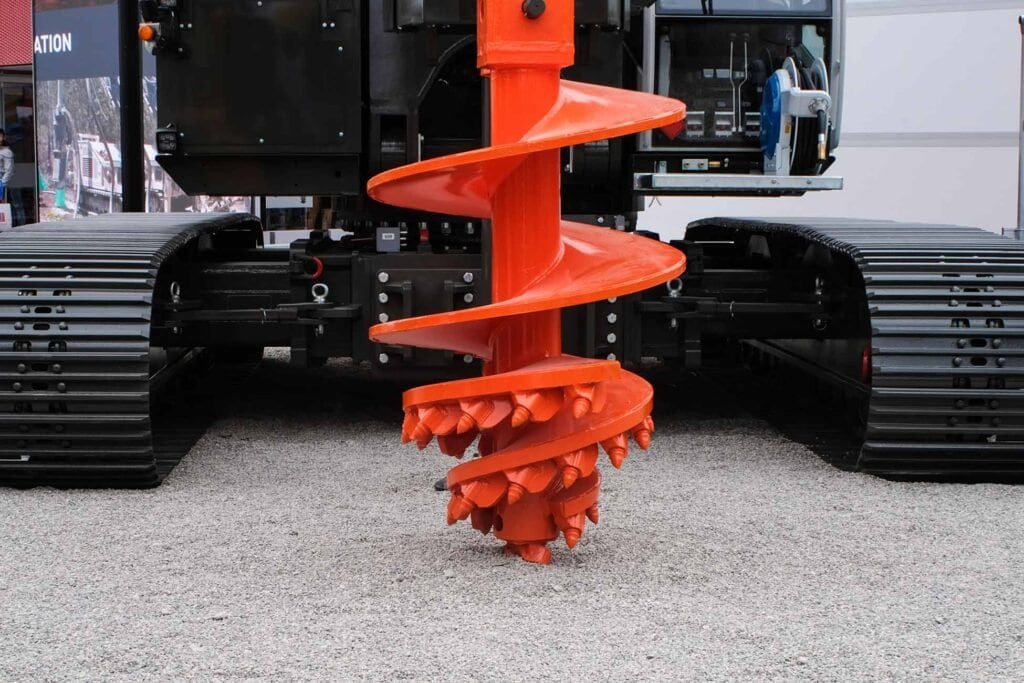
2. Types of Augers Used in Construction and Drilling
Augers are designed for different materials and project circumstances. Choosing the right auger for the job is essential to achieve your goals efficiently and accurately.
2.1. Earth Augers
Earth augers are some of the most common and are made specifically to bore into the ground. They are ideal for digging fence post holes, planting trees, or setting foundation supports in place.
Características clave:
- Come in different diameters to accommodate different hole sizes.
- Usually powered by handheld engines, skid steers, or excavators on larger projects.
- Work well in soft to moderately hard soil.
Aplicaciones:
- Installing fences, decks, and signposts.
- Digging holes for tree planting or landscaping.
- Creating foundational support for light structures.
2.2. Handheld Augers
Handheld augers are small and lightweight, designed for smaller projects where you need precision and control. You can get manual handheld augers, or you can get them with electric motors or gas engines.
Características clave:
- Compact design for easy maneuverability.
- Best suited for light-duty drilling tasks.
- Commonly used in gardens, landscaping, or residential construction.
Aplicaciones:
- Planting shrubs and trees.
- Installing small posts and signage.
- Drilling drainage holes in garden beds or pathways.
2.3. Hydraulic Augers
Hydraulic augers are heavy-duty attachments that connect to machinery such as excavators, backhoes, or skid steers. They are used for demanding projects that require more torque and penetration power.
Características clave:
- Powered by hydraulic systems for powerful and consistent drilling.
- Capable of drilling deeper and wider holes than standard augers.
- Suitable for hard soil, clay, and rocky conditions.
Aplicaciones:
- Digging foundation holes for commercial and industrial buildings.
- Installing large utility poles and light towers.
- Creating deep, stable holes for anchoring structures.
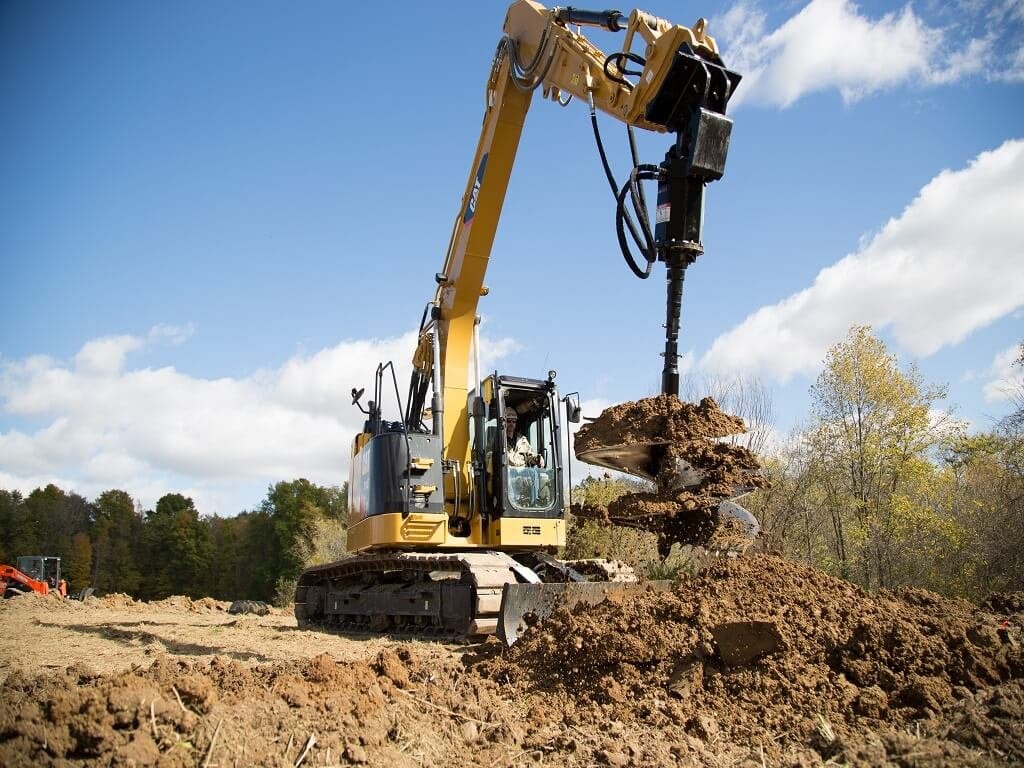
2.4. Ice Augers
Ice augers are specially designed for drilling holes through thick ice. They’re commonly used for ice fishing, winter construction projects, and scientific ice-core sampling.
Características clave:
- Equipped with sharp, serrated blades for cutting through ice effectively.
- Available in manual, electric, or gas-powered models.
- Designed for fast and precise ice penetration.
Aplicaciones:
- Creating ice fishing holes.
- Drilling ice cores for environmental studies.
- Clearing ice layers in frozen construction sites.
2.5. Rock Augers
Rock augers are strengthened drilling implements made for putting holes in hard, rocky ground. They’re usually tipped with heavy-duty carbide teeth because rocks are abrasive.
Características clave:
- Built with heavy-duty materials to endure rough terrain.
- Equipped with specialized teeth for improved cutting performance.
- Designed to handle hard surfaces such as rock, gravel, and compacted soil.
Aplicaciones:
- Excavating rocky construction sites.
- Drilling through dense soil layers.
- Installing structural supports in challenging terrain.
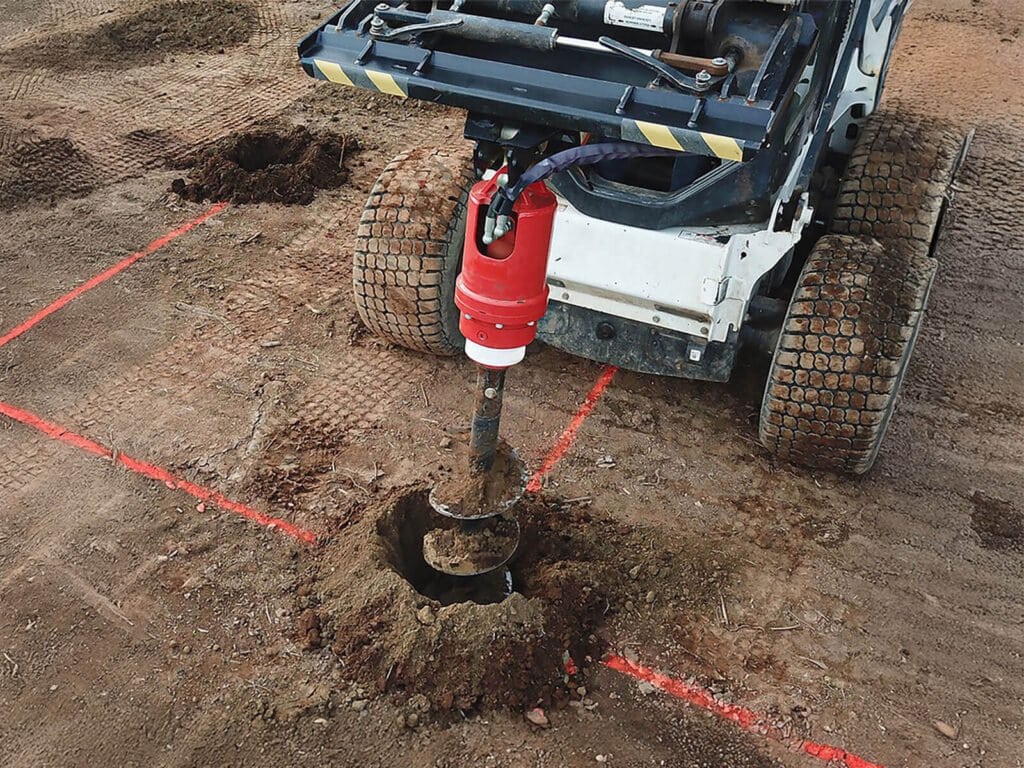
3. Common Uses of Augers in Construction
Augers are versatile and useful tools that serve multiple purposes in construction and industrial applications.
3.1. Foundation Drilling
Augers are great for drilling deep, stable holes needed for building footers and foundations. Hydraulic augers work especially well for these projects because of their power and accuracy.
Common Applications:
- Digging holes for concrete pilings.
- Creating stable ground anchors for tall structures.
- Installing support beams in commercial buildings.
3.2. Utility Pole Installation
An auger makes it easy to drill holes deep and straight enough for utility poles.
Common Applications:
- Installing electrical poles for power lines.
- Securing telecommunications and signage posts.
- Drilling foundation holes for solar panel structures.
3.3. Fence and Deck Posts
Augers are a great way to dig a bunch of holes in a uniform pattern and the same depth for fences and decks.
Common Applications:
- Installing residential and commercial fences.
- Constructing decks and outdoor patios.
- Building retaining walls for landscaping projects.
3.4. Landscaping and Tree Planting
Augers are great for digging holes when you’re planting trees, bushes, or other landscaping features.
Common Applications:
- Installing irrigation systems.
- Planting trees and shrubs with consistent spacing.
- Creating decorative landscape elements.
3.5. Geotechnical Drilling
Augers are also used by geotechnical engineers to pull up soil samples for testing.
Common Applications:
- Soil sampling for environmental studies.
- Testing ground stability before construction.
- Conducting geological surveys.

4. Advantages of Using an Auger
Augers do several things very well that make them a useful tool in construction, drilling, and landscaping, saving time and effort. Below are the main advantages of using an auger, explained in detail:
4.1. Improved Efficiency
The number one thing that augers do is drill holes fast and efficiently. The helical flighting of the auger pulls material up and out of the hole, saving you from having to lift it out yourself. This accelerates digging big time. This is why augers are so useful when you need to dig lots of holes like when installing a fence, setting up utility poles, or planting trees.
A hydraulic auger attached to an excavator can drill foundation holes several feet deep in minutes— a task that would take hours if you did it by hand. This kind of operational efficiency can reduce labor costs and project timelines.
4.2. Enhanced Precision
Also, an auger creates a clean, uniform hole with minimal ground disturbance. There are no ragged edges, and the hole is smooth, straight, and to the exact depth you want.
This precision is crucial for projects that require stable foundations, such as:
- Installing fence posts that must remain upright.
- Digging holes for piers, anchors, or structural supports.
- Landscaping projects where consistent hole spacing is essential.
When dealing with tough conditions (like compacted soil or rocky terrain), a hydraulic or rock auger gives you precision digging power.

4.3. Versatility Across Applications
Augers are extremely versatile, and there is an auger for most situations. Earth augers, ice augers, and rock augers can accommodate nearly any environment.
Key examples of auger versatility include:
- Soft Soil: Standard earth augers efficiently handle light-duty digging.
- Hard or Rocky Ground: Reinforced rock augers excel in penetrating tough surfaces.
- Ice Drilling: Ice augers are ideal for creating precise fishing holes or conducting ice-core sampling.
And, they come in all sizes from little handheld models to giant hydraulic attachments. You can use an auger for everything from planting flowers in your backyard to digging massive holes for construction.
4.4. Cost-Effectiveness
Augers save time and money. If you dig a foundation hole with a hydraulic auger, it takes minutes versus hours of back-breaking labor using a manual method.
For example:
- In fencing projects, augers ensure uniform post spacing, reducing material waste.
- In foundation drilling, the accuracy of augers minimizes the risk of structural misalignment, preventing costly corrections.
Moreover, augers designed for heavy machinery are built for durability, reducing equipment wear and tear and extending the lifespan of your tools.

5. Key Considerations When Choosing an Auger
It doesn’t matter how great your concept is if no one ever sees it. The secret to creating viral YouTube videos is basic. Create useful, exciting, and intriguing videos people will enjoy watching. Seriously.
5.1. Soil Type
The type of soil at your job site greatly influences the auger you should use:
- Soft or Loamy Soil: Standard earth augers are ideal for loose or moderately compacted soil. Their lightweight design allows for fast drilling without requiring excessive torque.
- Clay or Dense Soil: In areas with heavy clay or compacted dirt, a heavier-duty auger with sharper cutting blades will improve penetration.
- Rocky Terrain: For areas with gravel, stones, or solid rock, a rock auger with carbide-tipped teeth is recommended. These reinforced augers are designed to break through hard surfaces without damaging the equipment.
Choosing the right auger for your soil type ensures efficient drilling while minimizing wear on your equipment.
5.2. Auger Size
The size of the auger — particularly its diameter and length — should match your project’s drilling requirements.
- Smaller Augers (4″ to 8″ diameter): Ideal for planting shrubs, installing small posts, or creating drainage holes.
- Medium Augers (8″ to 18″ diameter): Commonly used for fence posts, deck footings, and tree planting.
- Large Augers (18″ to 36″+ diameter): Suitable for commercial foundation drilling, pole installation, and larger-scale construction projects.
For deeper holes, specialized auger extensions may be required to achieve the desired depth.
5.3. Equipment Compatibility
Augers are available as standalone manual tools or as attachments for various machinery. Choosing the correct attachment ensures compatibility with your equipment.
- Handheld Augers: Suitable for light-duty drilling, ideal for landscaping or small construction tasks.
- Skid Steer Augers: Designed for moderate to heavy-duty tasks, offering versatility for fence installation, signpost placement, and landscaping.
- Excavator-Mounted Augers: Engineered for demanding projects that require drilling deep or wide holes in challenging soil conditions.
Verifying the attachment type, hydraulic capacity, and mounting system is crucial to ensuring compatibility with your machinery.
5.4. Power Source
Choosing the right power source is essential for maximizing efficiency and performance:
- Manual Augers: Lightweight and portable, ideal for small gardening or landscaping tasks. Manual augers are budget-friendly but require physical effort.
- Electric Augers: Suitable for moderate workloads, electric augers offer consistent performance without the noise or fumes of gasoline models. They are ideal for residential use or indoor drilling.
- Gasoline-Powered Augers: Known for their power and mobility, gasoline augers excel in outdoor environments where electricity may be unavailable.
- Hydraulic Augers: The most powerful option, these are designed for heavy-duty construction projects that demand high torque and deep drilling capabilities.
Selecting the correct power source helps balance performance, convenience, and cost.

6. Auger Maintenance Tips for Optimal Performance
A post hole digger and a manual earth auger are essentially the same tool. The main difference is the quantity of work the user has to put into the process. Below are detailed maintenance tips to keep your auger in optimal condition:
6.1. Clean After Each Use
Regular cleaning is vital to maintaining your auger’s efficiency and preventing long-term damage. After each use, thoroughly remove soil, debris, or ice buildup from the auger’s flighting, cutting edges, and motor components.
- Soil and Mud Removal: Use a pressure washer or hose to clear away mud and clay, especially when working in sticky or heavy soil conditions.
- Rock and Gravel Debris: For rock augers, ensure no stones or gravel are lodged in the cutting teeth or flighting grooves.
- Ice and Frost: When using ice augers, melt any ice buildup to prevent blade dullness or rust formation.
Failing to clean your auger can result in hardened debris sticking to key components, reducing cutting efficiency and potentially causing mechanical strain.
6.2. Inspect Cutting Edges Regularly
Your auger’s cutting edges are critical for effective drilling. Dull or damaged blades reduce efficiency and place additional stress on the motor.
- Sharpen Blades: For standard earth augers, periodically sharpen the blades using a metal file or grinding tool. Sharpening should maintain the original angle of the cutting edge to preserve performance.
- Check for Wear: On rock augers, inspect carbide-tipped teeth for chipping or excessive wear. Replace any damaged or missing teeth to prevent reduced drilling power.
- Monitor Flighting Edges: Examine the spiral flighting for signs of bending or distortion. Warped flighting can reduce soil removal efficiency.
Performing frequent inspections ensures your auger maintains maximum cutting power and prevents costly breakdowns during operation.
6.3. Lubricate Moving Parts
Proper lubrication minimizes friction, reduces wear, and ensures smooth performance during operation. Focus on lubricating key moving parts to improve performance and extend component life.
- Hydraulic Motors: Regularly check the hydraulic motor’s oil level and ensure seals are intact to avoid leaks.
- Gearbox Components: For augers with gear-driven systems, apply high-quality grease to internal gears to reduce wear and prevent overheating.
- Auger Shaft and Mounting Points: Apply anti-seize lubricant on the auger shaft and connection points to prevent rust buildup and make future disassembly easier.

Using appropriate lubricants for each component helps reduce mechanical strain and maximizes efficiency.
6.4. Store Properly
Storing your auger in the right conditions helps prevent rust, corrosion, and damage when not in use.
- Clean Before Storage: Always clean and dry the auger before putting it away to avoid moisture buildup.
- Use Protective Covers: Cover the auger with a tarp or protective sleeve to shield it from dust, dirt, and weather exposure.
- Avoid Direct Contact with Soil or Concrete: Prolonged exposure to damp surfaces can accelerate rusting. Instead, store the auger on a dry, elevated platform.
- Temperature Considerations: If storing augers in extremely cold environments, ensure all moving parts are lubricated to prevent freezing.
Proper storage not only preserves the auger’s condition but also ensures it’s ready for immediate use in future projects.
6.5. Routine Inspection and Maintenance Schedule
Establishing a consistent maintenance schedule helps you detect potential issues before they develop into costly repairs.
| Maintenance Task | Frequency |
|---|
| Clean the auger after each use | After every project |
| Inspect cutting edges for wear or damage | Weekly (or before each use) |
| Lubricate moving parts | Monthly or as needed |
| Check hydraulic system for leaks | Monthly or after heavy usage |
| Store in a dry, protected area | After each use |
By following these maintenance guidelines, you can significantly improve your auger’s durability, enhance its performance, and reduce repair costs. Regular maintenance is essential, whether you’re using a handheld auger for landscaping or a powerful hydraulic auger for demanding construction tasks.
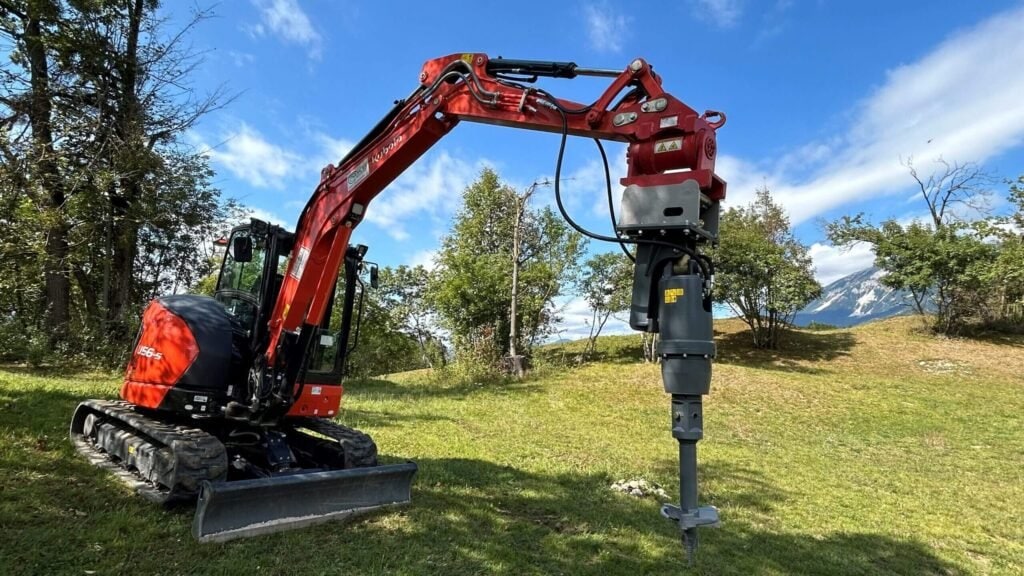
7. Auger Comparison Table
| Tipo | Mejor para | Power Source | Common Sizes | Características clave |
|---|
| Earth Auger | Soil digging, post holes | Manual / Hydraulic | 2″ – 18″ diameter | Efficient soil displacement |
| Handheld Auger | Small garden tasks | Manual / Electric | 4″ – 8″ diameter | Lightweight and easy to operate |
| Hydraulic Auger | Construcción de servicio pesado | Hydraulic Machinery | 6″ – 36″ diameter | High torque for tough conditions |
| Ice Auger | Drilling through ice | Manual / Gasoline | 4″ – 10″ diameter | Specialized blades for ice |
| Rock Auger | Drilling rocky terrain | Hydraulic Machinery | 6″ – 30″ diameter | Reinforced teeth for durability |

8. Conclusion
Whether you’re installing fence posts, planting trees, or tackling heavy-duty construction projects, an auger is an indispensable tool that enhances efficiency and accuracy. By selecting the right type of auger for your specific needs and following proper maintenance practices, you can ensure successful results in your construction or drilling tasks.